
It was a typical day at Pool Chlor of Arizona, a residential pool service business on the south side of Tucson, when I got a call from a local builder: a pool that he built for a family’s local summer home had a problem.
The family had flown into town for the weekend, and in the evening the homeowner decided to take a dip in his pool. He hopped in and — ouch! — landed on a bunch of sharp, prickly spines. The entire pool surface was coated with spiky white crystals. The deposit on the tile was so thick that you couldn’t even tell there was any tile there!
I went out to inspect the pool and this is what I saw.
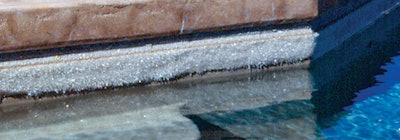
The crystals were amazing — I’d never seen anything like them in a pool. On the tile, they were about a half-inch long and skinny like little white blades. On the underwater surfaces the deposit was tan over the gray plaster, as many of the bladed crystals fell into the pool and adhered to the surface.
I tested the water chemistry. The chlorine, pH, alkalinity and cyanuric acid levels were all within standard. The hardness was relatively high, as was the level of dissolved solids. There was also measurable iron in the water — much more than usual in our area’s chlorinated pools.
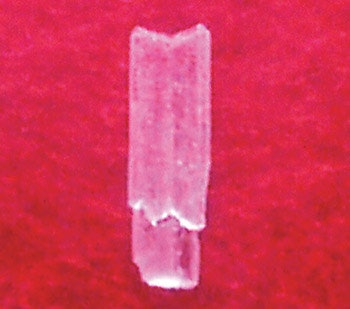
I called up my partner, Kim Skinner, and told him the facts of the case. After some consideration, he suggested that the deposits might be another form of calcium than the normal calcium carbonate — such as calcium sulfate. Calcium sulfate, CaSO4 (commonly called gypsum) can form crystals as evaporates in pools, and they are distinctive from the common calcium carbonate precipitates you often see in several key ways: First, they are softer (only 2 on the Mohs scale as opposed to calcium carbonate, which is a 3). Secondly, they are soluble in acid only if that acid is at boiling temperatures. And finally, they form what is called a “swallow-tail” crystalline structure. Since the deposition process is almost entirely an evaporative one, most if not all of the crystals will be at the tile or water surface line.
I got my other onBalance partner, Doug Latta, and together we went back to the pool to take another look.
The crystals indeed had a swallowtail form, like two parallelograms back to back.
Fingernails have a Mohs hardness of 2.5, while calcium sulfate is 2 and calcium carbonate is 3. Here is a calcium sulfate crystal that has been scratched on the side with a fingernail to show that the crystal is softer than the nail.
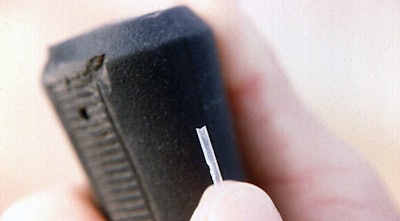
Considering all the evidence together, where the crystals had formed and especially their shape, we decided we were probably looking at Calcium Sulfate.
Now, room temperature acid will dissolve calcium carbonate, but not calcium sulfate. But heated (boiling) acid will dissolve the sulfate crystals. This picture shows us sanding some of the sulfate deposition layer off the top step.
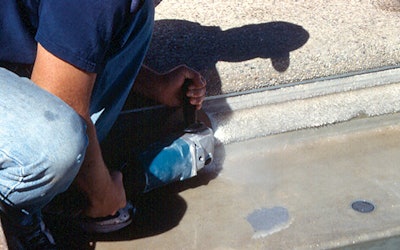
We then poured (non-heated) acid on the sulfate deposit near the sanded area, getting no reaction.
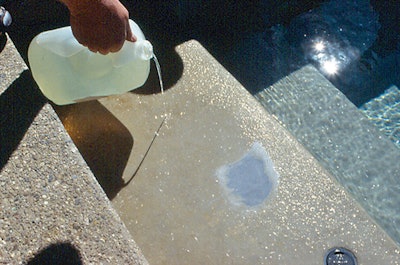
But when the acid hit the bare plaster — which contains calcium carbonate, which reacts with ambient temperature acid — it bubbled with this form of white effervescence.
We don’t have pictures of using the boiling acid, because when we were pouring boiling acid on the crystals, with clouds of fumes rising up, I was too focused on the job at hand and keeping the fumes out of my lungs to take photos — but it worked! The boiling acid dissolved the crystals!
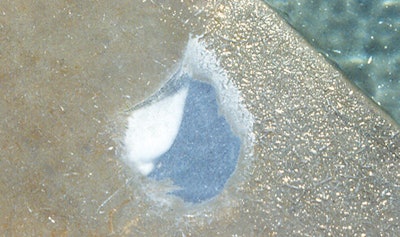
For a final verification, we submitted a sample of the crystals to the University of Arizona Chemistry lab for infrared spectroscopy. The IR scan confirmed they were indeed calcium sulfate.
Epilogue
Although in some isolated parts of the country, sulfate may be present in tap water, it is usually bicarbonate that occurs naturally as a major component of the water’s alkalinity. Generally speaking, if an appreciable amount of sulfate finds its way into pool water, it has been introduced as a component of treatment chemicals. These treatment chemicals can include one type of liquid pool acid (sulfamic acid), dry acid (sodium bisulfate), dechlorinators (sodium sulfite and sodium thiosulfate), and even non-chlorine shocks (such as persulfates). That’s what we think happened here.
This condition is relatively rare, so you may never see a pool with calcium sulfate deposits. But now, if you do, you’ll know what you are looking at!
Comments or thoughts on this article? Please e-mail [email protected].







































